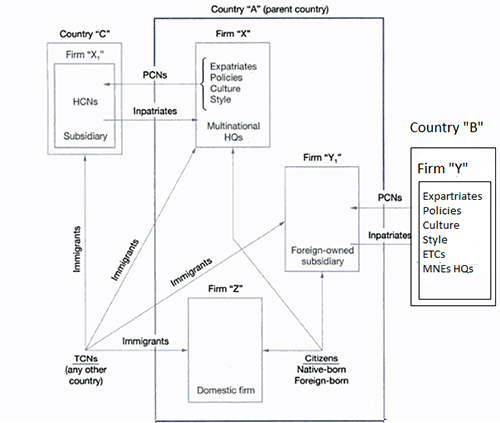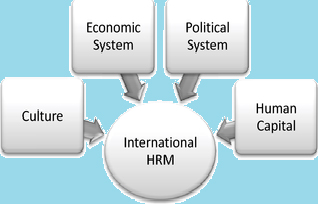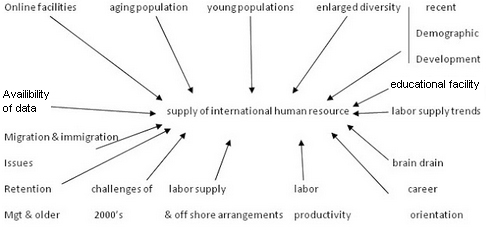International Human Resource Management (Human Resource Management)
Due to increased globalization and easy mobility and communications between countries, companies operate at international level. Major task for organizations which operate across international boundaries is to manage the dissimilar stresses of the drive for integration and differentiation. In broader sense, International human resource management process has same activities as in Domestic HRM such as planning and staffing however domestic HRM is operated in one nation And IHRM activities are involved in different countries. International Human Resource Management is a branch of management studies that examines the design and effects of organizational human resource practices in cross-cultural contexts. It occupies an exciting position in the interstices of international business, human resource management and organizational behaviour, scholarships. Theoretical studied explained that International HRM is the interplay between three dimensions: HR activities, the types of people being employed in the organisation and the different countries that an organisation is operating in (Dowling, 1999). Complexities caused by these last two variables, are what differentiates international HRM from domestic HRM, as the HR activities themselves are relatively similar.
Concept of International Human Resource Management
Broadly defined, International human resource management is the study and application of all human resource management activities as they impact the process of managing human resources in enterprises in the global environment. IHRM can be explained as "The set of distinct activities, functions and processes that are directed at attracting, developing and maintaining an MNC's human resources. It is the aggregate of the various HRM systems used to manage people in the MNC, both at home and overseas" (Taylor, Beechler et al. 1996). An international organization or firm is one in which operations take place in subsidiaries overseas, which rely on the business expertise or manufacturing capacity of the parent company. Such companies or organizations bring with them their own management attitudes and business styles.
Human resource managers of such organizations cannot afford to ignore the international influences on their work. International human resource management play significant role in providing solution to global business issues. Theorists explained that International HR management denotes to an extension of HR that relates to having people working abroad. These can be either expatriate staff, those who are recruited from or work within their own home countries (locally recruited staff), or even third country nationals (individuals from neither the 'parent' nor 'home' country, but rather a third country. The kinds of organizations in which this is the case can range from those with a small office or subsidiary based abroad, to major multinational corporations, international public-sector organizations, or international NGOs (charities) with sites all over the world. It can also encompass an organization working in a joint partnership with another organization overseas. Alternatively it could be a home based organization with overseas offices or a company with selected departments which are offshore. The differences between IHRM and HRM is that IHRM is being unpredictable and influenced more by external factors, requiring more functions, having continuously changing perspectives, requiring more intervention in employees' personal lives, and being more risky.
Major functions of International Human Resource Management
In International human resource management, there are five functional areas that include recruitment and selection, development and training, performance evaluation, remuneration and labor relations. In the first function of IHRM, Recruitment and selection, company employs new qualified candidates for international operations. Selection requires choosing from this pool the candidate whose qualifications most closely match the job requirements. Staffing is a complex function of international human resource management. In an global firms, the managing and staffing approach strongly affects the type of employee the company prefers. In a company with an ethnocentric approach, parent country nationals usually staff important positions at headquarters and subsidiaries. In recruitment and selection methods, firms consider both headquarters' practices and those widespread in the countries of its subsidiaries. Local culture also have great impact on recruitment and selection practices, and in some countries, local laws require a specific approach. In choosing the suitable candidate, it is needed to make balance between internal corporate consistency and sensitivity to local labor practices.
Another significant function of IHRM is Development and training which is aimed to offer sufficient training to personnel in a company and enable them to fulfil their goals, as well as show better performance and growth with their work. At global level, human resource development experts must have responsibility for training and development of employees located in subsidiaries around the world, specialized training to prepare expatriates for assignments abroad, and lastly development of a special group of worldwide minded managers. International human resource development programs may be done in two ways such as centralized and decentralized. In a centralized approach, training originates at the headquarters and corporate trainers travel to subsidiaries, often adapting to local situations. This fits the ethnocentric model. A geocentric approach is also centralized, and trainers could be sent from various positions in either the headquarters or subsidiaries to any other location in the company. In a decentralized approach, training is given locally, following a polycentric model. When training is decentralized, the cultural backgrounds of the trainers and trainees are usually similar. Local people develop training materials and techniques for use in their own area. It is important that trainer must be qualified.
Performance evaluation is the effective function of international human resource management. In companies, the performance evaluation is regularly performed for administration or development intentions. Usually, administration conduct evaluation when there is doubt of performance of candidate and there is a need of performance evaluation on work conditions of employees, promotions, rewards and/or layoffs. In multinational companies, performance appraisals are usually done annually and use a standardized evaluation form. Performance evaluation is complex task for International HR managers because the organization must evaluate employees from different countries working in different subsidiaries. Performance evaluation depends on the organization's overall human resource management strategy.
Remuneration and benefits is other functional approach of IHRM. Remuneration of employees plays an important role in hiring new employees because pay is the major source of people to live in the world. To develop an international system of compensation and benefits, firms have two primary concerns. The first is comparability. A good compensation system disperses salaries to employees that are internally equivalent and competitive within the marketplace. The international organization must also consider the salaries of people who may transfer from other locations. The second major concern is cost. Organizations struggle to reduce all expenses, and payroll is one of the largest.
Lastly, the labor relations function of IHRM which describes the role of management and workers in the workplace. In many countries, the government regulates labor relations practices.
Laurent (1986) recommends that international approach to human resource management would require numerous steps, Firstly, an explicit recognition by the parent organization that its own peculiar ways of managing human resources reflect some of the assumptions and values of its home culture. Secondly, an clear recognition by the parent organization that its peculiar ways are neither universally better nor worse than others, but are different and likely to exhibit strengths and weaknesses, particularly abroad. Next step is unambiguous recognition by the parent organization that its foreign subsidiaries may have other preferred ways of managing people that are neither intrinsically better nor worse, but could possibly be more effective locally. Next step is preparedness from headquarters not only to acknowledge cultural differences, but also to take action in order to make them discussable and therefore useable. Last step is developing genuine belief by all parties that more creative and effective ways of managing people could be developed as a result of cross-cultural learning.
Some people consider international HRM is similar to expatriate management. But IHRM has more importance and it includes more activities as compared to just the management of expatriates. It involves the international management of people. Although International HR managers assume the same activities as their domestically-based colleagues, the scope and intricacy of these tasks will depend on the extent of internationalisation of the organisation. Moving in global economy, organisations have to amend their traditional ways of managing people. The human factor is progressively more acknowledged as critical to organizational success. Theorists, Bohlander and Snell commented that "In the past, observers feared that machines might one day eliminate the need for people at work". Actually, just the opposite has been occurring. People are more important than earlier time.
In fast-growing economies, it is easy to access money and technology than good people. Competitive advantage belongs to companies that know how to attract, select, deploy, and develop talent. In multinational companies, major objective of HRM function is to make certain that the most effective use is made of its human resources. To accomplish this, HR professionals undertake a range of activities around sourcing, development, reward and performance management, HR planning, employee involvement and communications. If the organisation has a strategic HR function, these activities will support and inform organisational strategy. HR professionals are also used extensively in organisational change and development initiatives. For international organisations, these HR activities need to be co-ordinated across both the home country and different national subsidiaries and to take into account the needs of both parent country nationals (PCNs), host country nationals (HCNs) and third country nationals (TCNs).
Model of IHRM

The role of the IHR manager will differ and it depends on the international orientation of the organisation. It is critical that managers must be able to interpret international organisational strategy and develop IHR policies and practices which support that focus. As a strategic partner, the IHR manager should equally advise senior management of any mismatch between stated organisation internationalisation goals and actual IHR practice. In order to enhance the competitive advantage of firm, the IHR professionals must focus on their international competencies and learn about the basics of global business.
International human resource management

Strategies of International Human Resource Management
To respond major challenges in business, International HR executives are forced to formulate strategies and practices that will make their organizations successful. At the macro level, strategic global HRM is used to ensure that the organization overarching values, objectives and goals are supportedby the HR policies, procedures and practices (Brewster & Suutari, 2015). At the meso level, HR executives are mainly concerned to deal with issues relating to unions in the host country. At the micro level, HR executives are attempting to foster a global mindset among the workforce through developing HR competencies and business-related.
While implementing an IHR strategy, management team must ascertain the current and intended nature of international operations in the organisation (multi-domestic, international, global or transnational. Mangers should determine the extent to which HR policies and practices should be standardised or localised in accordance with overall organisational strategy. They must assess the extent to which local cultural, social, political, economic and legal factors will impinge on any attempts to apply standard HR policies if integration is a key factor in organisational strategy and ensure a computerised database of global human resources is used if integration is desired. In formulation of IHRM strategy, it is recommended to work with the senior management team to identify the competencies required to achieve global organisational objectives and also work with national HR and line managers to formulate IHR policies and practices in the key areas of sourcing, development and reward which will embed a transnational mindset in the organisation.
Major issues/ challenges of international human resource management
A crucial challenge for all international organisations is the need to achieve target in relation to the competing demands of global integration and co-ordination versus local responsiveness, the "global versus local" debate. Main challenges in IHRM include high failure rates of expatriation and repatriation, Deployment, getting the right mix of skills in the organization regardless of geographical location, Knowledge and innovation dissemination and managing critical knowledge and speed of information flow, Talent identification and development and identify capable people who are able to f unction effectively, Barriers to women in IHRM, International ethics, language (e.g spoken, written, body). Other challenges are Different labor laws, Different political climate, and different stage of technological advancement, different values and attitudes e.g. time, achievement risk taking, Roles of religion e.g. sacred objects, prayer, taboos, holidays, etc, Educational level attained, Social organizations e.g. social institutions, authority structures, interest groups, status systems.
Major issues for IHRM include the variety of international organizational models that exist, the extent to which HRM policy and practice should vary in different countries, the problem of managing people in different cultures and environments, the approaches used to select, deploy, develop and reward expatriates who could be nationals of the parent company or 'third-country nationals' (TCNs), nationals of countries other than the parent company who work abroad in subsidiaries of that organization. Cultural and environmental diversity is main problems in international HRM. Haley stated that in culture where people are emphasized, it is the quality of international relationships which is important. In cultures where ideologies are emphasized, sharing common beliefs is more important than group membership. Hofstede (1980) emphasizes that there are a number of cultural dimensions that affect international operations. Sparrow and Hiltrop (1997) recognize various HR areas that may be affected by national culture such as decisions on what makes an effective manager, giving face-to-face feedback, readiness to accept international assignments, pay systems and different concepts of social justice, approaches to organizational structuring and strategic dynamics.
These cultural differences mentioned gave the saying 'think globally and act locally'. This means that an international balancing act is essential, which leads to the important assumption given by Bartlett and Ghoshal (1991) that denotes 'Balancing the needs of co-ordination, control and autonomy and maintaining the appropriate balance are critical to the success of the multinational company.'
Figure: Challenges of IHRM

Ulrich (1998) proposed that to accomplish this balancing act, there are six capabilities that enable firms to integrate and concentrate international activities and also separate and adopt local activities that include being able to determine core activities and non-core activities, achieving consistency while allowing flexibility, building global brand equity while honouring local customs, obtaining leverage (bigger is better) while achieving focus (smaller is better, sharing learning and creating new knowledge andengendering a global perspective while ensuring local accountability.
Other problems are managing international assignments, employee and family adjustment, selecting the right person for international task, culture and communication barrier. Challenges of IHRM are clarifying taxation issues, coordinating foreign currencies, exchange rates, compensation plans, working directly with the families of employees, more involvement in employees personal life, facility etc, Different HR systems for different geographic locations, More complex external constituencies, foreign Governments, political and religious groups, heightened exposure to risks such as health, terrorism, legal issues, human and financial consequences of mistakes.
Figure: Issues in supply of international human resource:

Laurent (1986) stated that "in order to build, maintain and develop the corporate identity, multinational organizations need to strive for consistency in their ways of managing people on a worldwide basis. Yet, and in order to be effective locally, they also need to adapt those ways to the specific cultural requirements of different societies. While the global nature of business may call for increased consistency, the variety of cultural environments may be calling for differentiation."
From a business perspective, forces for global integration include operational requirements, strategic co-ordination and multinational customers. In contrast, forces for local responsiveness include highly diverse consumer requirements, tailored distribution channels and broader social and political constraints to market entry. From an HR perspective, there are many factors constraining the use of standardised HR practices including differing national business systems, labour laws, national HR practice, education systems and national cultural norms. Organisations still want to implement standardised HR systems internationally. Their option depends on their stage of internationalisation and international mindset. Major barriers to effective global HRM are variations, perception, of HR, Attitude and actions of headquarters towards, HR, resistance to change, cultural differences in learning and teaching styles.
To summarize, International human resource management has important role in a company to survive in global business. International HRM scrutinizes the way in which international organisations manage their human resources across these different national contexts It is a Procuring, Allocating, and Effectively utilizing human resources in a multinational corporation, while balancing the integration and differentiation of HR activities in foreign locations. HR managers have to sort out problems with globalisation and internationalisation due to dissimilar cultures, different policies or procedures, language and legislation. The International HRM assists in organizational remodel as it plays a role of innovator. International human resource management professionals have not only begun to frame their research in terms of organization theories, they are also increasingly using the international context to extend existing theories.

